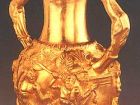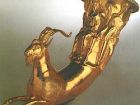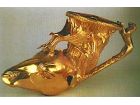THE PANAGYURISHTE TREASURE - THE SHINE OF THRACIAN ROYAL GOLD
THE PANAGYURISHTE TREASURE
THE SHINE OF THRACIAN ROYAL GOLD
THE SHINE OF THRACIAN ROYAL GOLD
- Look, I've found a strange whistle - one of the workers digging bricks near Panagyurishte exclaimed in 1949. His friends immediately dug the earth around and found several other gold objects having no idea that this was gold. They took them to the mayor's office where people immediately called the Plovdiv Archeological Museum. One of the museum specialists arrived and asked where the finds were. They told him that the wind instruments were in the closet. On seeing the find he was stupefied - the "wind instruments" represented a magnificent treasure, which is known as The Panagyurishte Treasure.
The Panagyurishte Treasure turned out to be an unbelievably beautiful set of ceremonial or religious type. It is made of high quality gold and its weight is 6 kg and 164 g. It consists of 9 vessels of specific form and original ornaments. In the first place there are four rhytons (drinking cups), with the typical for antiquity form of a bull's horn (this is the reason why the workers who found them thought they were musical instruments). Each of the rhytons is decorated with an exquisite head of an animal (a deer or a he-goat). The most impressive one is that with the he-goat's image.
Three of the vessels are decanters in the form of a female head. They have one handle ending on the upper end with an animal head and the torso or an image of a fabulous creature (centaur) in which we see the combination of animal figures with a human head.
Most interesting are the last two vessels. One of them resembles a shallow dish (called vial) and is decorated with bulging Negro heads, arranged in concentric circles, alternating with rows of plant elements (acorn). The second vessel is a large amphora (a vessel similar to a vase), richly decorated with scenes from Greek mythology and scenes primarily from Homer's Iliad.
The two handles of this amphora are also decorated with figures of centaurs. It is characteristic that all vessels (amphorae and decanters) have in their lower part an opening for drinking, which is important for the further interpretation of the whole set.
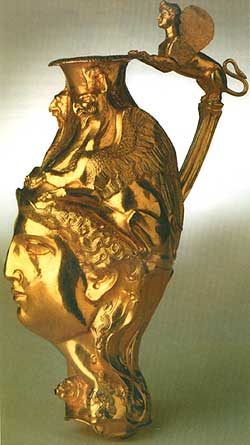
The rich decoration on the vessels is very professional. On the amphora we can see the judgment of Paris, the siege of a fortress (probably Troy) and other episodes from the Trojan War. These motifs lead us to the conclusion that the treasure was made in ancient Hellas (Greece), probably on the order of some of the richest Thracian rulers. But when did it happen and in which of the independent ancient Greek polis-towns?
The original idea of archeologists gives the answer to this question. It turns out that the unit of measure during this period, called drahma, and was different for each of these towns.
But since there are letters on some of the vessels of the Panagyurishte Treasure and they have numerical expression, they were weighed and in this way the precise value of the measure unit was determined. It became clear that this unit corresponds solely to the requirements of the town of Lampsak, a Hellenic colony on the southern Black Sea shore (in today's Turkey). We must presume then with high degree of certainty that the treasure from Panagyurishte was made in this ancient Greek town.
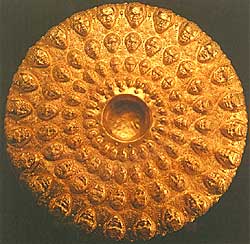
Together with many others finds all over Bulgarian land, the Panagyurishte Treasure confirms the stories of ancient Greek writers and historians that the Thracians, next to horses and wine, loved gold ornaments and jewelry most of all. They acquired them by means of war or as presents from foreign countries. The Panagyurishte Treasure probably came to Thrace on royal order by the mediation of merchants.
The function of this rich and expensive gold set is an important problem. It is highly probable that it was used during ceremonies. We must not disregard also the presumption that it had a ritual function since many of the drinking openings in most of the vessels remind of the sacred tradition of fraternization in which the simultaneous drinking from the same vessel connected the people drinking for the whole of their life.
The importance of the Panagyurishte Treasure for the history of ancient culture in our lands in the 4th c. BC is very great. In addition to its tremendous artistic value, it reveals the diverse cultural and historical processes of influence between Thracians and the rest of the world, with Hellenic culture in the first place.
For that reason it has long acquired world recognition as one of the most magnificent monuments in the world treasury of artistic values.





